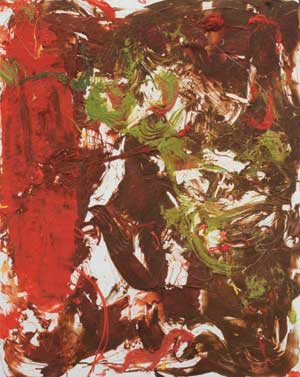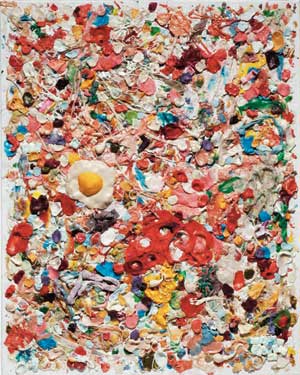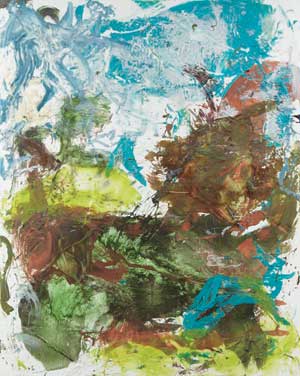Something to Chew On
by Jack Foran

Dan Colen: Shake the Elbow at Albright-Knox Art Gallery
When Marshall McLuhan pronounced that the medium is the message, he probably wasn’t thinking about bubble gum.



But he was right, in the case of artist Dan Colen. Bubble gum is the medium in Colen’s artwork currently on show at the Albright-Knox Art Gallery. And seems to be the message as well. What the works are about. Or mostly what they are about. The bizarre medium. These are paintings you can smell. They smell like Dubble Bubble. On a handout folder with the exhibit, smell is a touted feature.
The other main touted aspect of Colen’s art is that he makes his art from discarded materials. Not just used bubble gum—he talks about the connection of his work to the gum you might find if you look on the bottom of your seat in the movies and such—but abandoned bicycles in some other works, or bird droppings in place of paint, or perhaps paint artfully mixed and applied to look like bird droppings.
Well art should be new and different. (Not to actually try to tell art what it should be, but just to say that it should be interesting. And new seems to be an essential element of interesting. New as opposed to trite. And not to say either that what’s old can’t be interesting. But what’s new about what’s old. Even new to me or you.)
But making art from discarded materials isn’t new. Picasso made a wonderful piece from an old bicycle seat and handlebars. Robert Rauschenberg used to walk the New York City streets on garbage days, picking up stuff to make his art from. Letting what he picked up determine what art he would make that day. His great piece with a stuffed goat with a tire around its belly in a trash pile, chomping everything from old rags to tin cans. An image of the artist. And all the previous and subsequent artists that have proceeded much the same way. (Julian Montague—the discarded shopping carts project—Scott Bye, Robert Then and Richard Rockford, to name a few local art scene discarded materials artists.)
But it’s not the novelty of the materials but the novelty of how work on canvas looks that even more notably—principally—makes it interesting or no. In this respect again, this work doesn’t seem so new. Pretty old, in fact. About forty or fifty years, to be precise.
As you head down the corridor toward the Colen display—you see some of the bubble gum artwork on the end wall in front of you—the last two paintings in the corridor proper—one on each side, facing each other—are by Willem de Kooning (from 1977) and Karel Appel (from 1957). Icon examples of extremely variegated ecstatic gestural abstract expressionism. But art on a path—novel at the time, and historically interesting now—you really couldn’t go much further along.
Colen’s work treads the same path, only in bubble gum.
The bubble gum works are notably colorful. Particularly one called Scrambled or Fried (the only piece containing any representational element: what looks like a fried egg in the middle of the piece, blob of bright yellow on larger blob of pure white, among chaos of multicolors). Colen says on the handout folder in reference to this work, “I couldn’t invent that combination of colors.” I don’t know why not.
On his art in general, what he’s trying to do with it, using bubble gum, discarded bikes, bird droppings or facsimiles in paint, Colen says in a statement on a website, “I’m trying to equalise the world, to say there is no high and low.” As if this were a novel idea. It’s been around since the French Revolution at least. Since the time of Christ. Just before. “He has brought down the powerful from their thrones, and lifted up the lowly; he has filled the hungry with good things, and sent away the rich empty.”
The Dan Colen bubble gum art exhibit continues through October 18.

|
Issue Navigation> Issue Index > v14n27 (Week of Thursday, July 9) > Something to Chew On This Week's Issue • Artvoice Daily • Artvoice TV • Events Calendar • Classifieds |









 Current Issue
Current Issue